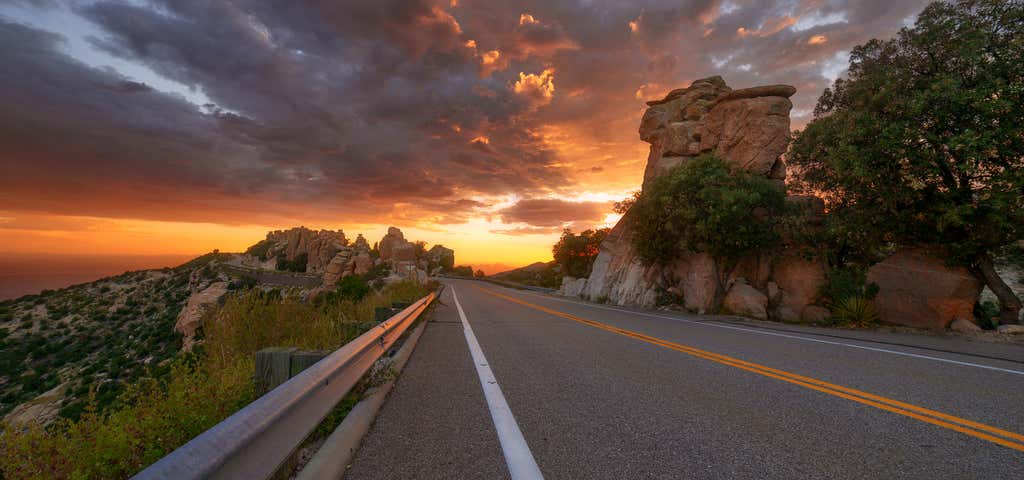You don’t have to travel far to experience all of Tucson’s natural beauty. From an urban garden in the heart of the city to a secret freshwater pool up in the mountains to a pine-filled forest on the southern edge of town, the terrain in this part of Arizona is as diverse as it is beautiful.
Located near the visitor center on the west side of Saguaro National Park, Signal Hill is an ideal place to visit for a few reasons. First, the hike up to Signal Hill and the main picnic area is short and relatively flat (with a few steps), so it’s accommodating for most hikers. Once you reach the hill, which is only 0.2 miles from the trailhead, you’ll be rewarded with excellent views of the surrounding saguaro forest—some of the views extend over 20 miles in multiple directions. There’s even a covered picnic ramada so you can enjoy your lunch in the shade. Additionally, Signal Hill is home to some of the best petroglyphs in all of Arizona. There are dozens of intricate rock drawings scattered around the base of the hill, which scientists believe date back to the 13th and 14th centuries.
A beautiful green space right in the middle of Oro Valley, the Canada del Oro Riverfront Park feels like an oasis. Despite the park's name, there technically isn't running water nearby, but that doesn’t mean there’s any shortage of things to do. This 30-acre park houses multiple sports courts, including basketball, tennis, and sand volleyball. There are also three covered picnic ramadas, two horseshoe pits, a covered playground, and a performance stage. And best of all, Canada del Oro Riverfront Park offers some of the best, unobstructed views of the surrounding mountains, including Mount Kimball and Mount Lemmon.
The best way to describe Hutch’s Pool is that it feels like your own secluded, personal pool in the mountains. Located seven miles up inside Sabino Canyon (about 16 miles roundtrip), Hutch’s Pool can be tricky to find and is not for the leisurely hiker—you will have to cross at least two streams and hike some rocky terrain before you can reach this remote swimming spot. But the trek is absolutely worth it, as the deep green pool seems to appear out of nowhere and is perfectly formed by surrounding boulders and large, smooth rocks. Due to its unique location, even if the nearby creeks and riverbeds are dry, you’ll almost always find water at Hutch’s Pool.
This well-known waterfall is both stunningly beautiful and easy to access. Located about a mile up Reddington Pass, just a short drive from the east side of Tucson, watch for when the paved road turns to dirt and then you’ll quickly spot the parking lot on your left. From there, it’s only two miles until you reach the 80-foot waterfall. Keep an eye out for a few other small falls and pools along the trail—while not as epic as Tanque Verde, they are still peaceful and beautiful additions to the hike. The best time to visit is between October and March, as this is when the weather is cooler (65-85 degrees) and the falls are running at their heaviest due to seasonal rains.
Located immediately west of the iconic "A" Mountain, Tumamoc Hill is an ideal place to escape the city and get a quick nature fix. In fact, Tumamoc is actually used by the University of Arizona as an active study site and ecological reserve. Because of this, it’s vital that all visitors stay on the paved paths and within the perimeter cables so as to not interfere with any natural habitats. Most people walk to the halfway point of the hill—there are bathrooms and water fountains here—but you can easily head all the way to the summit and enjoy some sprawling views of downtown Tucson.
While the name Mission Garden may conjure up an image of plotted fields and fresh produce, this place is something entirely unique and different. Mission Garden is actually considered to be a living agricultural museum—one that makes a point to showcase 4,000 years of Tucson’s history through heritage fruit trees, local heirloom crops, and edible native plants. Only open Wednesday through Saturday, this four-acre urban garden offers regular tours and workshops, and aims to educate visitors on the process of preserving and reviving the region’s rich agricultural heritage. A $5 per person donation is recommended if you visit.
If you think Tucson is all cactus and desert, then think again. Located in the Coronado National Forest at an elevation of almost 5,000 feet, Madera Canyon offers desert dwellers both a break from the heat in summer and fresh snow in winter. Not only will you find tall pine trees and plenty of hiking trails but you will also discover that Madera Canyon is home to some of the best birdwatching in the country. There are over 250 documented bird species here, including 15 species of hummingbirds and 36 species of wooden warblers. Due to the canyon’s location within a national forest, visitors will need to purchase a day pass for $8.
To make the most of these outdoor adventures, we recommend visiting in the cooler months—ideally between October and March. The weather is much more manageable and the crowds are often lower. Just remember to take your time, breath deep, and enjoy the endless open spaces.
Banner Photo Credit: By John D Sirlin
Visit Tucson
Tucson (pronounced TOO-sawn) is the second-largest city in the state of Arizona, with nearly one million residents in the metro area.









